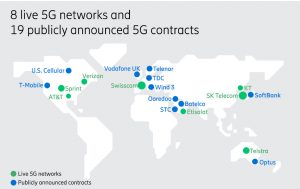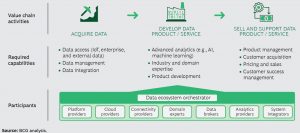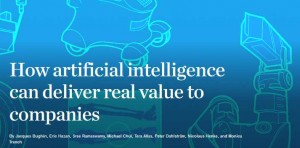
Companies new to the space can learn a great deal from early adopters who have invested billions into AI and are now beginning to reap a range of benefits.
After decades of extravagant promises and frustrating disappointments, artificial intelligence (AI) is finally starting to deliver real-life benefits to early-adopting companies. Retailers on the digital frontier rely on AI-powered robots to run their warehouses—and even to automatically order stock when inventory runs low. Utilities use AI to forecast electricity demand. Automakers harness the technology in self-driving cars.
A confluence of developments is driving this new wave of AI development. Computer power is growing, algorithms and AI models are becoming more sophisticated, and, perhaps most important of all, the world is generating once-unimaginable volumes of the fuel that powers AI—data. Billions of gigabytes every day, collected by networked devices ranging from web browsers to turbine sensors.
The entrepreneurial activity unleashed by these developments drew three times as much investment in 2016—between $26 billion and $39 billion—as it did three years earlier. Most of the investment in AI consists of internal R&D spending by large, cash-rich digital-native companies like Amazon, Baidu, and Google.
For all of that investment, much of the AI adoption outside of the tech sector is at an early, experimental stage. Few firms have deployed it at scale. In a McKinsey Global Institute discussion paper, Artificial intelligence: The next digital frontier?, which includes a survey of more than 3,000 AI-aware companies around the world, we find early AI adopters tend to be closer to the digital frontier, are among the larger firms within sectors, deploy AI across the technology groups, use AI in the most core part of the value chain, adopt AI to increase revenue as well as reduce costs, and have the full support of the executive leadership. Companies that have not yet adopted AI technology at scale or in a core part of their business are unsure of a business case for AI or of the returns they can expect on an AI investment.
However, early evidence suggests that there is a business case to be made, and that AI can deliver real value to companies willing to use it across operations and within their core functions. In our survey, early AI adopters that combine strong digital capability with proactive strategies have higher profit margins and expect the performance gap with other firms to widen in the next three years.
This adoption pattern is widening a gap between digitized early adopters and others. Sectors at the top of MGI’s Industry Digitization Index, such as high tech and telecoms or financial services, are also leading AI adopters and have the most ambitious AI investment plans. These leaders use multiple technologies across multiple functions or deploy AI at the core of their business. Automakers, for example, use AI to improve their operations as well as develop self-driving vehicles, while financial-services companies use it in customer-experience functions. As these firms expand AI adoption and acquire more data, laggards will find it harder to catch up.
Governments also must get ahead of this change, by adopting regulations to encourage fairness without inhibiting innovation and proactively identifying the jobs that are most likely to be automated and ensuring that retraining programs are available to people whose livelihoods are at risk from AI-powered automation. These individuals need to acquire skills that work with, not compete against, machines.
The future of AI will be innovative, but may not be shared equally. Companies based in the United States absorbed 66 percent of all external investments into AI companies in 2016, according to our global review; China was second, at 17 percent, and is growing fast. Both countries have grown AI “ecosystems”—clusters of entrepreneurs, financiers, and AI users—and have issued national strategic plans in the past 18 months with significant AI dimensions, in some cases backed up by billions of dollars of AI-funding initiatives. South Korea and the United Kingdom have issued similar strategic plans. Other countries that desire to become significant players in AI would be wise to emulate these leaders.
Significant gains are there for the taking. For many companies, this means accelerating the digital-transformation journey. AI is not going to allow companies to leapfrog getting the digital basics right. They will have to get the right digital assets and skills in place to be able to effectively deploy AI.
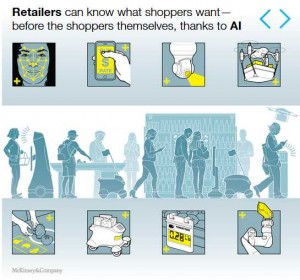

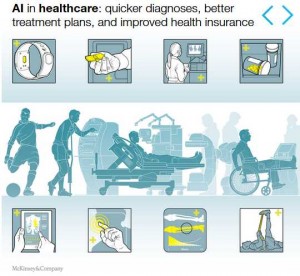
ARTIFICIAL INTELLIGENCE
Artificial intelligence is poised to unleash the next wave of digital disruption, and companies should prepare for it now. We already see real-life benefits for a few earlyadopting firms, making it more urgent than ever for others to accelerate their digital transformations. Our findings focus on five AI technology systems: robotics and autonomous vehicles, computer vision, language, virtual agents, and machine learning, which includes deep learning and underpins many recent advances in the other AI technologies. AI investment is growing fast, dominated by digital giants such as Google and Baidu. Globally, we estimate tech giants spent $20 billion to $30 billion on AI in 2016, with 90 percent of this spent on R&D and deployment, and 10 percent on AI acquisitions. VC and PE financing, grants, and seed investments also grew rapidly, albeit from a small base, to a combined total of $6 billion to $9 billion. Machine learning, as an enabling technology, received the largest share of both internal and external investment. AI adoption outside of the tech sector is at an early, often experimental stage. Few firms have deployed it at scale. In our survey of 3,000 AI-aware C-level executives, across 10 countries and 14 sectors, only 20 percent said they currently use any AIrelated technology at scale or in a core part of their businesses. Many firms say they are uncertain of the business case or return on investment. A review of more than 160 use cases shows that AI was deployed commercially in only 12 percent of cases.
Adoption patterns illustrate a growing gap between digitized early AI adopters and others. Sectors at the top of MGI’s Industry Digitization Index, such as high tech and telecom or financial services, are also leading adopters of AI. They also have the most aggressive AI investment intentions. Leaders’ adoption is both broad and deep: using multiple technologies across multiple functions, with deployment at the core of their business. Automakers use AI to develop self-driving vehicles and improve operations, for example, while financial services firms are more likely to use it in customer experience–related functions. Early evidence suggests that AI can deliver real value to serious adopters and can be a powerful force for disruption. In our survey, early AI adopters that combine strong digital capability with proactive strategies have higher profit margins and expect the performance gap with other firms to widen in the future. Our case studies in retail, electric utilities, manufacturing, health care, and education highlight AI’s potential to improve forecasting and sourcing, optimize and automate operations, develop targeted marketing and pricing, and enhance the user experience.
AI’s dependence on a digital foundation and the fact that it often must be trained on unique data mean that there are no shortcuts for firms. Companies cannot delay advancing their digital journeys, including AI. Early adopters are already creating competitive advantages, and the gap with the laggards looks set to grow. A successful program requires firms to address many elements of a digital and analytics transformation: identify the business case, set up the right data ecosystem, build or buy appropriate AI tools, and adapt workflow processes, capabilities, and culture. In particular, our survey shows that leadership from the top, management and technical capabilities, and seamless data access are key enablers. . AI promises benefits, but also poses urgent challenges that cut across firms, developers, government, and workers. The workforce needs to be reskilled to exploit AI rather than compete with it; and countries serious about establishing themselves as a global hub for AI development will need to join the global competition to attract AI talent and investment; and progress will need to be made on the ethical, legal and regulatory challenges that could otherwise hold back AI.

More in the discussion paper: Artificial intelligence: The next digital frontier?
About the authors:Jacques Bughin is a director of the McKinsey Global Institute, Michael Chui is an MGI partner, and Tera Allas is an MGI visiting fellow; Eric Hazan is a senior partner in the Paris office; Sree Ramaswamy is a partner in the Washington, DC, office; Peter Dahlström and Nicolaus Henke are senior partners in the London office, where Monica Trench is a consultant.
